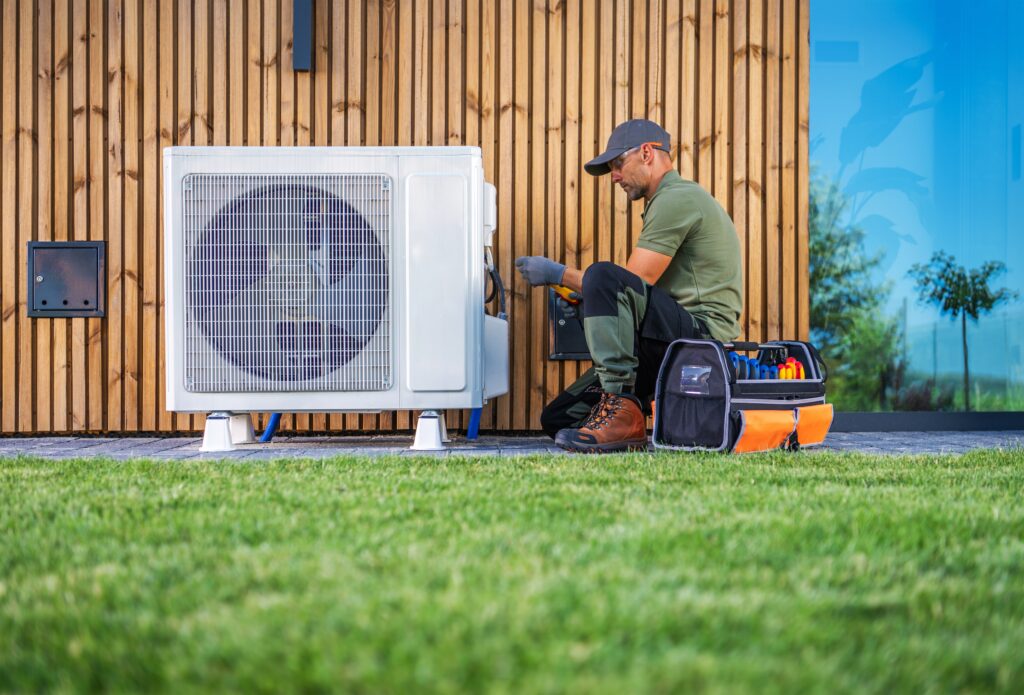Best HVAC Tips to Beat the Humidity This Summer

Sticky floors, clammy skin, and that heavy, damp feeling in the air—yep, summer humidity has officially arrived. If you’re like most homeowners, you know just how uncomfortable and even unhealthy high humidity can make your home feel.
Your HVAC system can do a lot more than just cool things down—it can also help keep excess moisture in check.With the right setup and a few smart strategies, you can keep your indoor air feeling cool, dry, and breathable.
In this guide, we’ll walk through some of the best HVAC tips to beat the humidity this summer—from running your AC more efficiently to adding a dehumidifier and sealing up moisture leaks.
Table of Contents
Understand the Impact of High Humidity on Your Home
High humidity isn’t just uncomfortable, it can mess with your whole home. When there’s too much moisture in the air, your space can feel warmer than it actually is, making your AC work overtime just to keep things feeling cool. That means higher energy bills and more wear and tear on your system.
Beyond comfort and cost, excess humidity can also hurt your indoor air quality. Mold and mildew love damp environments, and those extra moisture levels create the perfect breeding ground—especially in places like basements, bathrooms, and around windows. Over time, that can lead to musty odors, allergy flare-ups, and even structural issues if left unchecked.
Not sure if your home’s humidity is too high? Here are some signs to look out for:
- A constant muggy or clammy feeling in the air
- Condensation or fog forming on your windows
- That unmistakable musty smell in certain rooms
- Sticky surfaces or walls that feel damp to the touch
If any of that sounds familiar, it might be time to take a closer look at how your HVAC system is handling humidity.
Use Your Air Conditioner Effectively
Your air conditioner does more than just pump out cold air—it also helps pull moisture from the air as it cools your home. That’s because as warm, humid air passes over the evaporator coils, the moisture condenses and drains away. So every time your AC runs, it’s actually doing double duty: lowering the temperature and reducing humidity levels.
But here’s the catch—your AC has to be running efficiently to do its job well. If it’s short-cycling or constantly set to super low temps, it might not be removing as much moisture as it should.
A few easy ways to help your AC work smarter:
- Set your thermostat to around 72–75°F—lower isn’t always better, and you’ll give your system more time to pull moisture out of the air.
- Keep your fan set to “auto,” not “on.” When it’s always on, moisture that collects on the coils can get blown right back into the air.
- Use a programmable or smart thermostat to avoid overcooling and to maintain a steady temp throughout the day.
If your system is older or struggling to keep up with the humidity, it might be time to think about an upgrade. Newer models are much better at controlling both temperature and moisture—and they’re more energy-efficient, too. If your AC is more than 10–15 years old or constantly in need of repairs, investing in a modern, high-efficiency unit could make a huge difference in your comfort and energy bills.
Install a Whole-Home Dehumidifier
If your home still feels sticky and uncomfortable even with the AC running, it might be time to bring in some backup. Whole-home dehumidifiers work alongside your HVAC setup to pull excess moisture out of the air, and the difference in comfort can be massive.
Unlike portable units that only handle one room at a time, a whole-home dehumidifier connects directly to your ductwork and treats your entire house. That means no lugging machines from room to room, no noisy fans, and no buckets to empty. Just consistently dry, breathable air throughout your home.
Yes, the upfront cost can be a bit of an investment—typically ranging from $1,500 to $3,000 installed—but many homeowners find the value well worth it. Not only does it make your home feel cooler and less muggy, but it can also:
- Prevent mold, mildew, and musty smells
- Protect wood floors, furniture, and walls from moisture damage
- Help reduce allergy symptoms and improve air quality
Lastly, it takes some of the pressure off your AC. When humidity levels are lower, your air conditioner doesn’t have to work as hard or run as long to keep things comfortable. That can lead to lower energy bills and less wear and tear on your HVAC system.
So if your house feels more like a rainforest than a retreat this summer, a whole-home dehumidifier might be exactly what you need.
Keep Air Filters Clean
When it comes to beating summer humidity, don’t overlook something as simple as your HVAC air filter. A dirty, clogged filter might not seem like a big deal, but it can seriously mess with your system’s ability to keep your home cool and dry.
Here’s why: when filters are packed with dust and debris, they restrict airflow. That makes it harder for your AC to circulate air properly—and when air isn’t moving efficiently, your system can’t pull moisture out the way it should. So instead of feeling crisp and comfortable, your home stays sticky and sluggish.
During the humid summer months, it’s a good idea to check your filter at least once a month and replace it every 30 to 60 days, or even more often if you have pets, allergies, or live in a high-pollen area.
Not sure which filter to use? For better airflow and moisture control, look for:
- Pleated filters (they trap more particles without restricting airflow)
- Filters with a MERV rating between 8–13—high enough to catch dust and allergens, but not so high that it chokes your system
- Electrostatic filters, which can help attract moisture and particles for cleaner, drier air
Think of it this way: keeping your air filter clean is one of the easiest things you can do to help your HVAC system perform better. It’s a small task with big results when it comes to comfort and efficiency.
Seal and Insulate Your Home
Even the best HVAC system can’t do its job if humid air is constantly sneaking into your home. Think of your house like a cooler—if there are cracks or gaps letting warm, moist air in, your AC has to work way harder just to keep things comfortable. And that means more humidity, higher energy bills, and a less comfortable home overall.
One of the biggest culprits? Gaps around doors, windows, vents, and even electrical outlets. These little leaks might not seem like much, but they can add up fast—especially in older homes. Taking time to seal them up can make a big difference in how well your home holds in cool, dry air.
A few simple DIY weatherproofing fixes to get you started:
- Use caulk to seal cracks around windows, baseboards, and trim
- Add weatherstripping to doors to block out drafts
- Install door sweeps to seal that gap at the bottom of exterior doors
But it’s not just about the visible leaks—your attic and ductwork also play a big role. Poorly insulated attics let heat and humidity pour into your home, especially in the summer. And leaky ducts can pull in warm, humid air from unconditioned spaces like crawlspaces or garages.
To help your HVAC system out:
- Make sure your attic has adequate insulation, especially around entry points and recessed lighting
- Have your ducts inspected and sealed if needed
- Consider insulating exposed ductwork in basements, attics, or crawlspaces to keep cool air cool
Sealing and insulating isn’t the most glamorous home project, but it’s one of the most cost-effective ways to keep humidity out, comfort in, and your HVAC system running smoothly.
Use Smart Thermostats and Humidity Sensors
If you’re still using an old-school thermostat, it might be time for an upgrade—especially if humidity is a constant battle in your home. Smart thermostats and humidity sensors aren’t just cool gadgets; they’re game-changers when it comes to keeping your indoor air comfortable and balanced.
Most smart thermostats today can monitor both temperature and humidity, helping you keep levels in the ideal range—between 30% and 50%. That sweet spot is where the air feels dry enough to be comfortable but not so dry that it irritates your skin or sinuses.
If humidity spikes or your HVAC system isn’t keeping up, your thermostat can notify you right away. It’s a great way to catch issues early before they lead to bigger problems like mold or system strain.
Another perk is integration. Many smart thermostats can be connected to your AC, dehumidifier, or even a whole-home automation system. That means if the humidity rises, your system can kick on automatically to bring it back down.
Schedule Regular HVAC Maintenance
Your HVAC system works hard—especially during those hot, sticky summer months. And just like your car needs regular oil changes to run smoothly, your AC needs seasonal check-ups to stay in top shape. Scheduling regular HVAC maintenance, especially before summer hits full swing, can save you from mid-season breakdowns and help keep your home’s humidity levels in check.
A good tune-up does more than just make sure the air is blowing cold. Your technician will inspect and clean the parts that directly impact how well your system removes moisture, including:
- Evaporator coils (which help pull moisture from the air)
- Refrigerant levels (low refrigerant = poor cooling and dehumidifying)
- Condensate drain lines (clogs here can lead to water backup and higher humidity)
- Airflow and duct checks to make sure everything’s running efficiently
These tune-ups catch small issues before they turn into big problems—and help your system run more efficiently, meaning less energy use and better humidity control. It’s a win-win: your home stays cooler, drier, and more comfortable, and your HVAC system lasts longer with fewer surprise repairs.
Consider a Zoned HVAC System
If you’ve ever walked upstairs and felt like you stepped into a sauna—or found your basement feeling like a damp cave—you’re not alone. Humidity and temperature can vary a lot from room to room, especially in larger or multi-story homes. That’s where a zoned HVAC system comes in clutch.
Zoning lets you divide your home into different “zones,” each with its own thermostat and level of control. That means you can adjust the temperature and humidity in specific areas, like that sunny upstairs bedroom that always overheats or the basement that never seems to dry out.
For homeowners with sunrooms, finished basements, or big open layouts, zoning is a game-changer. It helps your HVAC system work smarter, not harder, by only sending cool, dry air where it’s needed—rather than blasting the whole house just to fix one problem area.
Some of the biggest benefits?
- Better comfort control room by room
- Reduced energy waste, since you’re not cooling the whole house unnecessarily
- Improved humidity management, especially in tricky zones like basements or rooms with lots of windows
If you’re constantly fiddling with the thermostat or running fans and dehumidifiers in certain rooms, it might be time to look into zoning. It’s a smart way to boost both comfort and efficiency.
Conclusion
Dealing with summer humidity doesn’t have to mean sweating it out indoors. With the right HVAC strategies, you can keep your home feeling cool, dry, and comfortable no matter how hot it gets outside.
The key is getting ahead of the game. Don’t wait until you’re dripping with sweat or spotting mold in the corners. A few proactive steps now can make a big difference later.
Ready to beat the heat? Schedule a professional HVAC check-up today to prepare your home!

Anna has over six years of experience in the home services and journalism industries and serves as the Content Manager at MyHomePros.com, specializing in making complex home improvement topics like HVAC, roofing, and plumbing accessible to all. With a bachelor’s degree in journalism from Auburn University, she excels in crafting localized, comprehensive guides that cater to homeowners’ unique needs. Living on both coasts of the United States has equipped her with a distinctive perspective, fueling her passion for turning any house into a cherished home through informed, personalized decision-making.








